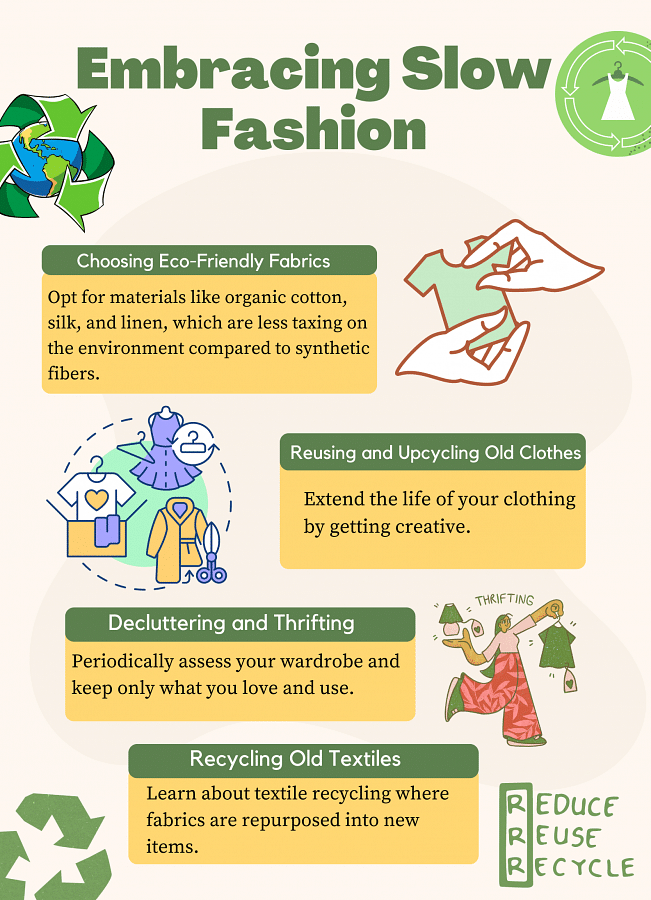Please explain Slow Fashion

In an era dominated by "fast fashion", where clothing items are produced rapidly by mass-market retailers to meet the latest trends, the "slow fashion" movement presents a conscientious alternative. Slow fashion is about prioritising quality over quantity, focusing on sustainability, and making ethical choices that benefit the environment and society.
This movement encourages consumers to shift towards more sustainable, eco-friendly fabrics, and practices such as reusing, decluttering, thrifting, and recycling, to cultivate a more sustainable wardrobe.
Choosing eco-friendly fabrics
A cornerstone of the slow fashion movement is the selection of eco-friendly textile. Unlike synthetic fibres, which are often petroleum-based and non-biodegradable, natural materials like cotton, silk, and linen are less harmful to the environment.
Organic cotton is grown without harmful chemicals and consumes less water compared to conventional cotton. Silk, known for its durability and luxurious feel, is biodegradable and has a relatively low environmental impact when sourced responsibly. Linen, made from the flax plant, not only boasts high durability but is also fully biodegradable and recyclable.
By choosing garments made from these materials, consumers can significantly reduce their ecological footprint.
Reusing and upcycling old clothes
Slow fashion also emphasises the importance of extending the life of clothing. Instead of discarding garments that are out of style or slightly damaged, upcycling provides a creative avenue to rejuvenate them.
This approach not only curbs the need to produce new materials but also sparks creativity, as old items are transformed into new, unique pieces. Upcycling can involve simple modifications such as adding new buttons or embellishments; it can even involve transforming an old dress into a chic top or a skirt, giving old fabrics a new lease on life.

Decluttering and thrifting
Another aspect of embracing slow fashion is through mindful decluttering and thrifting.
Decluttering involves evaluating one's wardrobe and retaining items that are genuinely needed or loved, thus minimising waste. The discarded items can then be donated or sold, rather than ending up in a landfill.
On the other hand, thrifting allows individuals to purchase second-hand garments. This practice not only extends the life cycle of clothing but also reduces the demand for new garments, thus lowering the overall environmental impact of our clothing choices.
Recycling old textile
When clothes are beyond repair or no longer suitable for donation, recycling is a viable option. Textile recycling involves breaking down fabrics to create raw materials for new products, thus conserving resources and reducing reliance on virgin materials.
This process helps mitigate the fashion industry's impact by decreasing the volume of waste sent to landfills and reducing the need for new resources.
Every step counts
Each step taken towards adopting slow fashion can have a significant positive impact on the environment. By choosing sustainable fabrics, reusing and upcycling clothes, thrifting, and recycling, individuals can contribute to a more sustainable world.
The slow fashion movement is not just about changing how we buy clothes—it's about changing our perspective towards fashion and our consumption habits. It promotes a culture of caring—caring for the environment, for the people involved in the production processes, and for the quality and longevity of the garments we wear.
In embracing slow fashion, we take a step towards a more ethical and sustainable future, making a statement that fashion, at its best, can be both beautiful and responsible.
Illustration: Ayman Anika

 For all latest news, follow The Daily Star's Google News channel.
For all latest news, follow The Daily Star's Google News channel. 







Comments